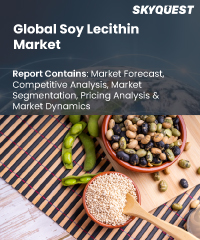
Product ID: SQMIG30C2113

Report ID:
SQMIG30C2113 |
Region:
Global |
Published Date: February, 2024
Pages:
157
|
Tables:
97 |
Figures:
76
Soy Lecithin Market size was valued at USD 547.5 million in 2019 and is poised to grow from USD 588.7 million in 2023 to USD 984.2 million by 2031, growing at a CAGR of 7.7% in the forecast period (2024-2031).
Lecithin is a dietary ingredient that may be found in soy, among other sources. It is often added to food as an emulsifier or lubricant, but it may also be used as an antioxidant and taste preserver. Soy lecithin, like many food additives, is not without controversy. Many people think it could be harmful to their health. However, very few, if any, of these assertions are supported by hard data. Due to the existence of consumers who are price-sensitive, lecithin manufacturers compete on the basis of competitive pricing. In order to stand out from the competition, manufacturers place a strong emphasis on process innovation and the source of their low-cost raw materials. Additionally, when lecithin production expands and end-use sectors including food, beverage, feed, and pharmaceutical expand quickly, this tends to exceed the gap between supply and demand, leading to mild price increases anticipated during the projection period.
For example, in the fourth quarter of 2021, Deoiled Soya Lecithin Powder costs were skyrocketing in the Asian market. Prices were skyrocketing in the Chinese market, supported by a drop in soybean imports from the US following a disruption in market dynamics brought on by storms. Throughout Q4 FY22, China saw a considerable increase in the cost of deoiled lecithin powder made from soy. Deoiled soy lecithin powder prices increased by 4.38 percent in India as a result of increased freight costs and increased demand from ongoing winter holidays. Deoiled soy lecithin powder was estimated to cost USD 4092.24 per MT on a CFR basis.
Due to the shutdown of several industrial facilities, the coronavirus pandemic has brought about a global stop in a number of industries, including the food and beverage and pharmaceutical sectors. Companies that produce soy lecithin had trouble keeping up with demand because to labour shortages, company closures of manufacturing facilities, transportation constraints, and hiccups in the supply of raw materials. The Black Sea region's sunflower seed production in 2019 declined by almost 20% from an average year, totaling 14,1 million t in Ukraine and 13,27 million t in Russia. India produced up to 10,45 million t of soybeans. Despite these data, prices of IP soy and sunflower lecithin fell to their all-time lows in December 2020 and January 2021 as a result of a decline in demand brought on by the COVID lockout and the entry of new competitors.
US Soy Lecithin Market is poised to grow at a sustainable CAGR for the next forecast year.
Our industry expert will work with you to provide you with customized data in a short amount of time.
REQUEST FREE CUSTOMIZATIONSoy Lecithin Market size was valued at USD 547.5 million in 2019 and is poised to grow from USD 588.7 million in 2023 to USD 984.2 million by 2031, growing at a CAGR of 7.7% in the forecast period (2024-2031).
Want to customize this report? This report can be personalized according to your needs. Our analysts and industry experts will work directly with you to understand your requirements and provide you with customized data in a short amount of time. We offer $1000 worth of FREE customization at the time of purchase.

Product ID: SQMIG30C2113